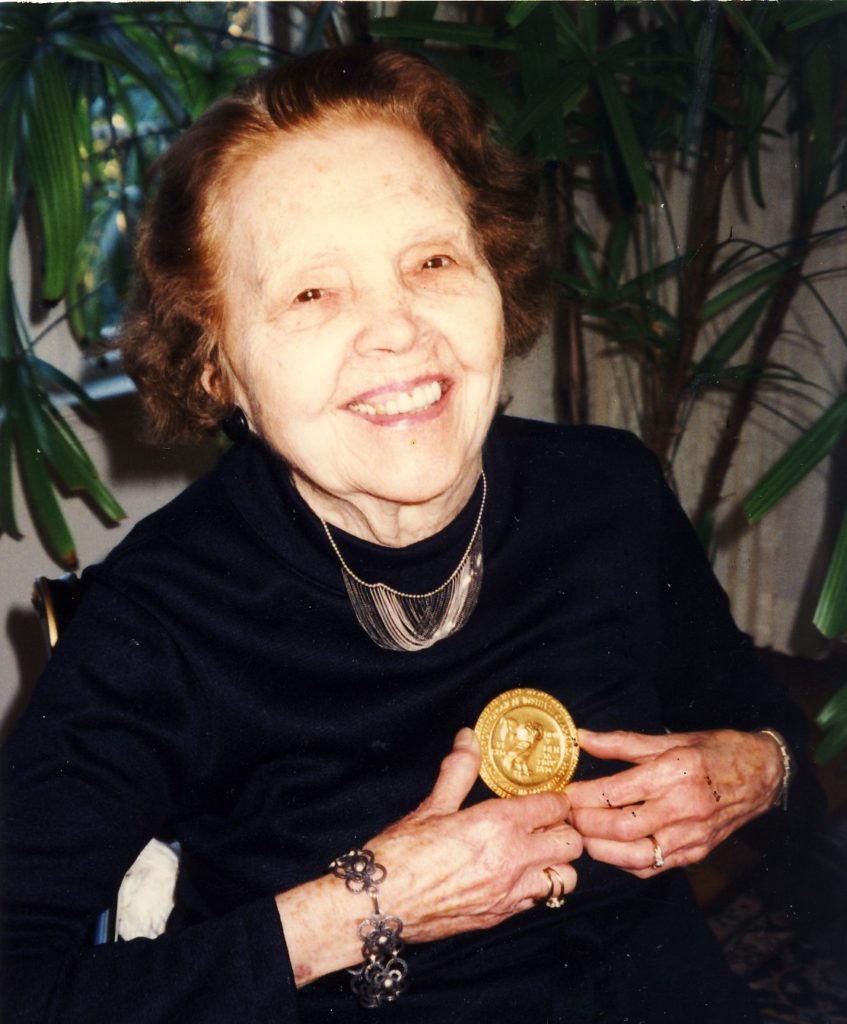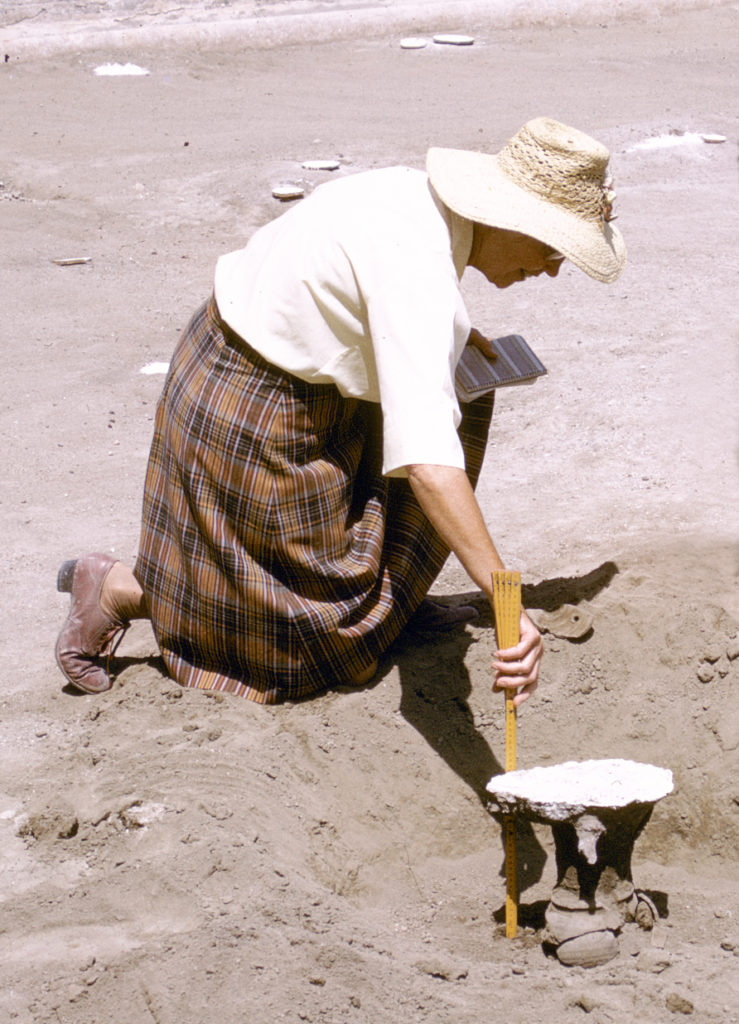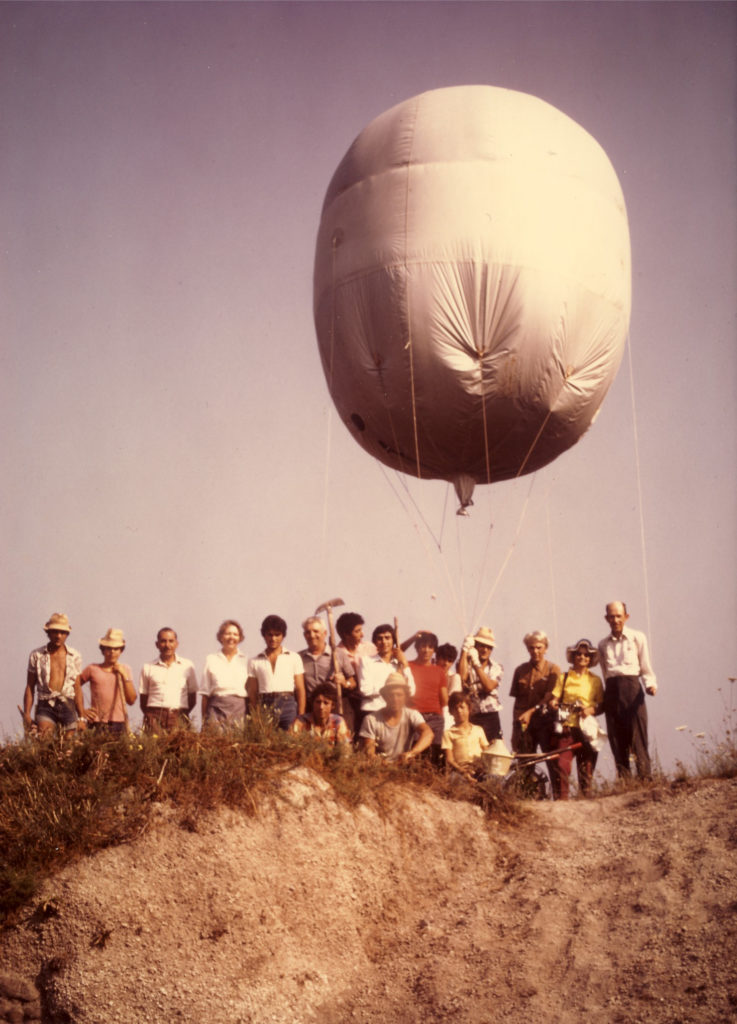
April is National Garden Month and we would like to honor Wilhelmina Jashemski, the noted pioneer of garden archaeology. Wilhelmina Jashemski is perhaps best known for her contributions to the archaeology of Pompeii, where she focused on the evidence of gardens and worked to help us imagine them as the settings for daily life in the ancient city. A trailblazer in the field of garden archaeology, and a winner of the AIA’s Gold Medal for Distinguished Archaeological Achievement, Jashemski’s contributions inspired generations of archaeologists, students of ancient culture, and the public.
We reached out to Kathryn Gleason and Amina-Aïcha Malek to learn more about Wilhelmina Jashemski’s life and work, and why they believe she is an archaeologist you should know.
Kathryn Gleason is professor of landscape architecture and archaeology at Cornell University. She is a specialist on the archaeology of Roman gardens, known for her development of a systematic methodology for the excavation of designed landscapes outside of the Vesuvian region, as well as studies in the design and construction of Roman gardens. She has excavated 18 ancient gardens in Jordan, Israel, and Italy and is the editor of a Cultural History of Gardens in Antiquity (Bloomsbury 2014) and co-editor of Gardens of the Roman Empire (2018).
Amina-Aïcha Malek is a researcher at the CNRS laboratory Archéologie & Philologie d’Orient et d’Occident (AOROC) of the École Normale Supérieure. (ENS) and Paris Sciences Lettres Research University (PSL). An expert on Roman Garden archaeology and the reception of landscape mosaics in their architectural setting, she was a Special Garden Archaeology Fellow at Dumbarton Oaks (1999-2002) and has collaborated on garden excavations internationally. She is co-editor of Gardens of the Roman Empire (2018), editor of The Sourcebook for Garden Archaeology (2013), co-founder of the Society for Garden Archaeology, and Project Director of the Programme de recherche archeologique de Lambese-Tazoult, Algeria.
What got you intrigued about Wilhelmina Feemster Jashemski?
When you think about it, there is not much left of a garden, park, or vineyard after two millennia but Wilhelmina Jashemski’s lectures and her richly illustrated books, The Gardens of Pompeii (2 vols.), The Natural History of Pompeii, and, The Gardens of the Roman Empire, have brought the scant remains vividly back to life. Integrating literature, art, and scientific studies, she pieced together a compelling picture of daily practices and horticultural techniques in the urban gardens, villas, and cultivated landscapes buried by the eruption of Mt. Vesuvius in 79 CE, revealing aspects of life in the garden that had never been portrayed in previous scholarship.

Please share one anecdote that you see as representative of Jashemski and her work.
At Wilhelmina Jashemski’s 90th birthday gathering, generations of women recounted how much she had helped them in their academic careers, whether it was weighing in to help a mother of grown children return to complete a degree, or to encourage them through challenging times, or how not to suffer a fool. For some of us, she was the only tenured woman faculty member or field director we knew during our student years, and she was a model of who we wanted to be. Her influence continued through her retirement as she mentored new generations of archaeologists and ancient historians.
What do you see as Jashemski chief achievements?
Wilhelmina Jashemski was a leading founder of the discipline of garden archaeology as it emerged in the 1980s and 1990s. Her early scholarship as an ancient historian was on Roman law, and her publications in that area and her engaging teaching gained her tenure at the University of Maryland – no small accomplishment for a woman at that time. Then she turned to her real passion, the study of how everyday Romans lived. She dared to see gardens as serious topic of scholarly investigation, the setting for the full range of activities of daily life in antiquity, from dining and recreation to religion and business activity. Seeing that a full understanding of garden culture could not be achieved through texts alone, she undertook a survey of garden sites around the Roman Empire that led to her first archaeological excavations at Pompeii–at age 50!
After 20 years of developing a methodology, she published Gardens of Pompeii in two volumes, recording 642 gardens and 210 wall paintings, and interpreting them in a book of essays. She went on to gather a group of scientists for The Natural History of Pompeii, underlining the importance of integrating the humanities and sciences in garden and landscape archaeology. Then, in 1988, she resumed her work on The Gardens of the Roman Empire, the most ambitious of several projects that occupied her later years. She emphasized that “garden archaeology at its best is an international venture”, and she gathered nearly 100 authors, across disciplines and around the Mediterranean, to find the remains of the gardens, but then to look beyond them to much larger issues of culture, religion, science, and life. The Gardens of the Roman Empire was published posthumously in 2018 and the compendium of all known gardens will be published April 2021.
Through her development of a range of field methodologies, she catalyzed the field of garden archaeology, organizing conferences and editing volumes on the subject, as well as guiding the development of The Sourcebook for Garden Archaeology (2014). Ultimately, through her humanities courses, public talks, and publications for scholars, students, popular audiences, and children, she successfully brought to life the vibrant garden culture of the Romans to a wide international audience. In 1996, she was honored with the AIA Gold Medal for Distinguished Archaeological Achievement.

Finally, explain in 50 words (or so) why Wilhelmina Feemster Jashemski is an archaeologist the public should know more about.
Wilhelmina Jashemski was an innovative scholar and much of her success came through perseverance. Raised on the plains of York, Nebraska, she was inspired to become a classicist by reading The Last Days of Pompeii as a girl, persisting in her studies through the Great Depression and Second World War to complete a distinguished PhD and gain tenure at a time when few women held that position. She was fortunate in the support of her husband, Stanley, a physicist, who supported her academic career and dedicated his vacations to assisting her in the field as photographer, draftsman, and manager. After her retirement and the death of her husband, she continued to excavate and publish, a model of gracefully pushing through the difficulties of loss and aging to build a community of garden archaeologists and lay the foundations of a new area of study in classical archaeology.
To learn more about Wilhelmina Feemster Jashemski and her work, explore the following:
Notifications